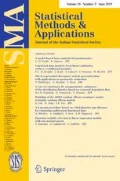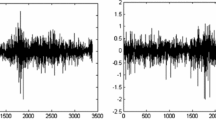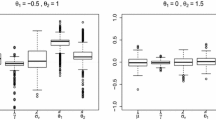Abstract
Stochastic Volatility models have been considered as a real alternative to conditional variance models, assuming that volatility follows a process different from the observed one. However, issues like the unobservable nature of volatility and the creation of “rich” dynamics give rise to the use of non-linear transformations for the volatility process. The Box–Cox transformation and its Yeo–Johnson variation, by nesting both the linear and the non-linear case, can be considered as natural functions to specify non-linear Stochastic Volatility models. In this framework, a fully Bayesian approach is used for parametric and log–volatility estimation. The new models are then investigated for their within-sample and out-of-sample performance against alternative Stochastic Volatility models using real financial data series.
Similar content being viewed by others
References
Anderson T, Bollerslev T, Lange S (2003) Modeling and forecasting realized volatility. Econometrica 71: 579–625
Atkinson AC (1985) Plots, transformations, and regression. Oxford University Press, Oxford
Berg A, Meyer R, Yu J (2004) The DIC as a model comparison criterion for stochastic volatility models. J Bus Econ Stat 22: 107–120
Box GEP, Cox DR (1964) An analysis of transformations. J R Stat Soc Ser B 26: 1–78
Box GEP, Jenkins GM (1973) Some comments on a paper by Chatfield and Prothero and on a review by Kendall. J R Stat Soc Ser A 135: 1–78
Brooks S, Gelman A (1998) General methods for monitoring convergence of iterative simulations. J Comput Graph Stat 7: 434–455
Chib A, Nardari F, Shephard N (2002) Markov chain Monte Carlo methods for stochastic volatility models. J Econom 108: 181–316
Clark PK (1973) A subordinate stochastic process model with fixed variance for speculative prices. Econometrica 45: 135–156
Davidson R, McKinnon JG (1993) Estimation and inference in econometrics. Oxford University Press, New York
Draper NR, Cox DR (1969) On distributions and their transformations to normality. J R Stat Soc Ser B 31: 472–474
Fleming J, Ostdiek B, Whaley RE (1995) Predicting stock market volatility: a new measure. J Futures Markets 15: 265–302
Galbraith JW, Kisinbay T (2005) Content horizons for conditional variance forecasts. Int J Forecast 21: 249–260
Gallant AR, Hsieh D, Tauchen G (1997) Estimation of stochastic volatility models with diagnostics. J Econom 81: 159–192
Gelman A, Carlin JB, Stern HS, Rubin DB (2004) Bayesian data analysis. Chapman and Hall, London
Gelman A, Rubin DB (1992) Inference from iterative simulation using multiple sequences. Stat Sci 7: 457–511
Geweke J (1994) Comments on bayesian analysis of stochastic volatility. J Bus Econ Stat 12: 371–417
Giacomini R, White H (2006) Tests of conditional predictive ability. Econometrica 74: 1545–1578
Harvey AC, Ruiz E, Shephard N (1993) Multivariate stochastic volatility models. Rev Econ Stud 61: 247–264
Hastings WK (1970) Monte Carlo sampling methods using markov chains and their applications. Biometrika 57: 97–109
Higgins ML, Bera A (1992) A class of nonlinear ARCH models. Int Econ Rev 62: 137–158
Hinkley DV (1975) On power transformations to symmetry. Biometrika 62: 101–112
Hol E, Koopman SJ (2002) Forecasting the variability of stock index returns with stochastic volatility models and implied volatility. Tinbergen Institute Discussion Papers 00-104/4, Tinbergen Institute
Hull J, White A (1987) Hedging the risk from writing foreign currency options. J Int Money Finance 6: 131–152
Jacquier E, Polson NG, Rossi PE (1994) Bayesian analysis of stochastic volatility models (with discussion). J Bus Econ Stat 12: 371–417
Jacquier E, Polson NG, Rossi PE (2004) Bayesian analysis of stochastic volatility models with fat-tails and correlated errors. J Econom 122: 185–212
Kass RE, Carlin BP, Gelman A, Neal R (1998) Markov chain monte carlo in practice: a roundtable discussion. Am Stat 52: 93–100
Martens M (2002) Measuring and forecasting s&p 500 index-futures volatility using high-frequency data. J Futures Markets 22: 497–518
Patton A (2006) Volatility forecasting comparison using imperfect volatility proxies. Research Paper Series 175, Quantitative Finance Research Center, University of Technology, Sydney
Poirier DJ (1978) The use of the box–cox transformation in limited dependent variable models. J Am Stat Assoc 73: 284–287
Shephard N (1994) Partial non-gaussian state space. Biometrika 81: 115–131
Shephard N, Pitt MK (1997) Likelihood analysis of non-gaussian measurement time series. Biometrika 84: 653–667
Spiegelhalter DJ, Best N, Carlin BP, var den Linde A (2002) Bayesian measurements of model flexibility and fit (with discussion). J R Stat Soc B 64: 583–639
Tsiotas G (2002) Nonlinearities in stochastic volatility models. Ph.D thesis, University of Essex, UK
Tsiotas G (2007) On the use of the Box–Cox transformation on conditional variance models. Finance Res Lett 4: 28–32
Van Zwet WR (1964) Convex transformations of random variables. Mathemetisch Centrum, Amsterdam
Yeo IK, Johnson RA (2000) A new family of power transformations to improve normality or symmetry. Biometrika 87: 954–959
Yu J, Yang Z, Zhang X (2006) A class of nonlinear stochastic volatility models and its implications for pricing currency options. Comput Stat Data Anal 51: 2218–2231
Zhang X, King ML (2007) Box–Cox stochastic volatility models with heavy-tails and correlated errors. J Empir Finance (forthcoming)
Author information
Authors and Affiliations
Corresponding author
Rights and permissions
About this article
Cite this article
Tsiotas, G. On the use of non-linear transformations in Stochastic Volatility models. Stat Methods Appl 18, 555–583 (2009). https://doi.org/10.1007/s10260-008-0113-9
Accepted:
Published:
Issue Date:
DOI: https://doi.org/10.1007/s10260-008-0113-9




